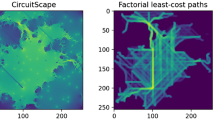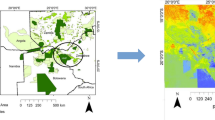Abstract
Context
Dispersal typically consists of three components—departure, transience and settlement—each of which can be influenced by the landscape. A fundamental aspect of dispersal is the dispersal kernel, which describes how the likelihood of settlement varies as a function of the distance from the departure location. Dispersal concepts are often closely connected to the interpretation of landscape connectivity, yet models of landscape connectivity often do not generate dispersal kernels nor explicitly capture the three components of dispersal.
Objectives
We apply Markov chain theory for the generation of random-walk dispersal kernels that are based on the three components of dispersal to better link dispersal processes to landscape connectivity.
Methods
We extend the spatial absorbing Markov chain (SAMC) framework, which is aimed at addressing a broad range of problems in landscape connectivity, to explicitly model dispersal kernels that acknowledge each component of the dispersal process and how the landscape can alter each of these components. We provide an example with the Florida black bear (Ursus americanus floridanus), a species of conservation and management concern, where we contrast expected connectivity between key subpopulations when models do and do not consider random-walk dispersal kernels.
Results
Our extensions show how the SAMC can generate different types of random-walk kernels that include information on how the landscape alters departure, transience and settlement processes. Importantly, this framework can also readily incorporate mortality into predictions and be applied to make time-explicit predictions across landscapes. Connectivity for the Florida black bear is predicted to be much lower when acknowledging dispersal kernels and suggests that the settlement process may be more influential to connectivity predictions than landscape resistance.
Conclusion
These results provide a foundation for applying the SAMC to dispersal kernels. Not only do these extensions provide a formal linkage of connectivity to concepts in dispersal biology, but also help to bring together concepts from common connectivity models (e.g., circuit theory and least-cost resistant kernels) to facilitate predicting connectivity across landscapes.






Similar content being viewed by others
Data availability
Data for bear example are provided at Figshare (https://figshare.com/; DOI: https://doi.org/10.6084/m9.figshare.22776218).
Code availability
We provide the R code used to generate examples in Figures 2-3 using the samc package in the Supporting Information. Code for the black bear example is deposited at Figshare (https://figshare.com/:DOI: https://doi.org/10.6084/m9.figshare.22776218).
References
Acevedo MA, Sefair JA, Smith JC, Reichert B, Fletcher RJ Jr (2015) Conservation under uncertainty: optimal network protection strategies for worst-case disturbance events. J Appl Ecol 52:1588–1597
Albert CH, Rayfield B, Dumitru M, Gonzalez A (2017) Applying network theory to prioritize multispecies habitat networks that are robust to climate and land-use change. Conserv Biol 31(6):1383–1396
Baguette M, Blanchet S, Legrand D, Stevens VM, Turlure C (2013) Individual dispersal, landscape connectivity and ecological networks. Biol Rev 88(2):310–326
Bocedi G, Zurell D, Reineking B, Travis JMJ (2014) Mechanistic modelling of animal dispersal offers new insights into range expansion dynamics across fragmented landscapes. Ecography 37(12):1240–1253
Bonte D, Van Dyck H, Bullock JM et al (2012) Costs of dispersal. Biol Rev 87(2):290–312
Bowler DE, Benton TG (2005) Causes and consequences of animal dispersal strategies: relating individual behaviour to spatial dynamics. Biol Rev 80(2):205–225
Brennan A, Hanks EM, Merkle JA et al (2018) Examining speed versus selection in connectivity models using elk migration as an example. Landsc Ecol 33(6):955–968
Brodie JF, Mohd-Azlan J, Schnell JK (2016) How individual links affect network stability in a large-scale, heterogeneous metacommunity. Ecology 97(7):1658–1667
Bullock JM, Gonzalez LM, Tamme R et al (2017) A synthesis of empirical plant dispersal kernels. J Ecol 105(1):6–19
Clobert J, Baguette M, Benton TG, Bullock JM (eds) (2012) Dispersal ecology and evolution. Oxford University Press, Oxford
Codling EA, Plank MJ, Benhamou S (2008) Random walk models in biology. J R Soc Interface 5(25):813–834
Compton BW, McGarigal K, Cushman SA, Gamble LR (2007) A resistant-kernel model of connectivity for amphibians that breed in vernal pools. Conserv Biol 21(3):788–799
Cushman SA, Landguth EL (2012) Multi-taxa population connectivity in the Northern Rocky Mountains. Ecol Model 231:101–112
Cushman SA, Elliott NB, Bauer D et al (2018) Prioritizing core areas, corridors and conflict hotspots for lion conservation in southern Africa. PLoS ONE. https://doi.org/10.1371/journal.pone.0196213
Dickson BG, Albano CM, Anantharaman R et al (2019) Circuit-theory applications to connectivity science and conservation. Conserv Biol 33(2):239–249
Diniz MF, Cushman SA, Machado RB, De Marco P (2020) Landscape connectivity modeling from the perspective of animal dispersal. Landsc Ecol 35(1):41–58
Dixon JD, Oli MK, Wooten MC, Eason TH, McCown JW, Paetkau D (2006) Effectiveness of a regional corridor in connecting two Florida black bear populations. Conserv Biol 20(1):155–162
Etherington TR (2016) Least-cost modelling and landscape ecology: concepts, applications and opportunities. Curr Landsc Ecol Rep 1:40–53
Fandos G, Talluto M, Fiedler W, Robinson RA, Thorup K, Zurell D (2023) Standardised empirical dispersal kernels emphasise the pervasiveness of long-distance dispersal in European birds. J Anim Ecol 92(1):158–170
Fletcher RJ Jr, Acevedo MA, Reichert BE, Pias KE, Kitchens WM (2011) Social network models predict movement and connectivity in ecological landscapes. Proc Natl Acad Sci USA 108:19282–19287
Fletcher RJ Jr, Revell A, Reichert BE, Kitchens WM, Dixon JD, Austin JD (2013) Network modularity reveals critical scales for connectivity in ecology and evolution. Nat Commun 4:2572
Fletcher RJ Jr, Burrell N, Reichert BE, Vasudev D (2016) Divergent perspectives on landscape connectivity reveal consistent effects from genes to communities. Curr Landsc Ecol Rep 1(2):67–79
Fletcher RJ Jr, Sefair JA, Wang C et al (2019) Towards a unified framework for connectivity that disentangles movement and mortality in space and time. Ecol Lett 22(10):1680–1689
Fletcher RJ, Sefair JA, Kortessis N et al (2022) Extending isolation by resistance to predict genetic connectivity. Methods Ecol Evol 13(11):2463–2477
Greenwood PJ, Harvey PH (1982) The natal and breeding dispersal of birds. Annu Rev Ecol Syst 13:1–21
Guisan A, Thuiller W, Zimmermann NE (2017) Habitat suitability and distribution models: applications with R. Cambridge University Press
Hanski I (1999) Metapopulation ecology. Oxford University Press
Heller NE, Zavaleta ES (2009) Biodiversity management in the face of climate change: a review of 22 years of recommendations. Biol Conserv 142(1):14–32
Holmes EE, Lewis MA, Banks JE, Veit RR (1994) Partial-differential equations in ecology: spatial interactions and population-dynamics. Ecology 75(1):17–29
Hughes J, Lucet V, Barrett G et al (2023) Comparison and parallel implementation of alternative moving-window metrics of the connectivity of protected areas across large landscapes. Landsc Ecol 54:412
Kareiva PM, Shigesada N (1983) Analyzing insect movement as a correlated random walk. Oecologia 56(2–3):234–238
Koenig WD, VanVuren D, Hooge PN (1996) Detectability, philopatry and the distribution of dispersal distances in vertebrates. Trends Ecol Evol 11(12):514–517
Larkin JL, Maehr DS, Hoctor TS, Orlando MA, Whitney K (2004) Landscape linkages and conservation planning for the black bear in west-central Florida. Anim Conserv 7:23–34
Maehr DS (1996) The comparative ecology of bobcat, black bear and Florida panther in south Florida. University of Florida, Gainesville
Maehr DS, Smith JS, Cunningham MW, Barnwell ME, Larkin JL, Orlando MA (2003) Spatial characteristics of an isolated Florida black bear population. Southeast Nat 2(3):433–446
Marx AJ, Wang C, Sefair JA, Acevedo MA, Fletcher RJ (2020) SAMC: an R package for connectivity modeling with spatial absorbing Markov chains. Ecography 43(4):518–527
McRae BH, Dickson BG, Keitt TH, Shah VB (2008) Using circuit theory to model connectivity in ecology, evolution and conservation. Ecology 89(10):2712–2724
Nathan R, Getz WM, Revilla E et al (2008) A movement ecology paradigm for unifying organismal movement research. Proc Natl Acad Sci USA 105(49):19052–19059
Nathan R, Klein E, Robledo-Arnuncio JJ, Revilla E (2012) Dispersal kernels: reivew. In: Clobert J (ed) Dispersal ecology and evolution. Oxford University Press, Oxford
Ovaskainen O, Luoto M, Ikonen I, Rekola H, Meyke E, Kuussaari M (2008) An empirical test of a diffusion model: predicting clouded Apollo movements in a novel environment. Am Nat 171(5):610–619
Paradis E, Baillie SR, Sutherland WJ (2002) Modeling large-scale dispersal distances. Ecol Model 151(2–3):279–292
Peterman WE (2018) ResistanceGA: an R package for the optimization of resistance surfaces using genetic algorithms. Methods Ecol Evol 9:1638–1647
Peterman WE, Pope NS (2021) The use and misuse of regression models in landscape genetic analyses. Mol Ecol 30(1):37–47
Pfluger FJ, Balkenhol N (2014) A plea for simultaneously considering matrix quality and local environmental conditions when analysing landscape impacts on effective dispersal. Mol Ecol 23(9):2146–2156
Robertson EP, Fletcher RJ Jr, Cattau CE et al (2018) Isolating the roles of movement and reproduction on effective connectivity alters conservation priorities for an endangered bird. Proc Natl Acad Sci USA 115:8591–8596
Saerens M, Achbany Y, Fouss F, Yen L (2009) Randomized shortest-path problems: two related models. Neural Comput 21(8):2363–2404
Sawyer SC, Epps CW, Brashares JS (2011) Placing linkages among fragmented habitats: do least-cost models reflect how animals use landscapes? J Appl Ecol 48(3):668–678
Schnell JK, Harris GM, Pimm SL, Russell GJ (2013) Estimating extinction risk with metapopulation models of large-scale fragmentation. Conserv Biol 27(3):520–530
Sefair JA, Smith JC, Acevedo MA, Fletcher RJ (2017) A defender-attacker model and algorithm for maximizing weighted expected hitting time with application to conservation planning. IISE Trans 49(12):1112–1128
Slatkin M (1993) Isolation by distance in equilibrium and nonequilibrium populations. Evolution 47(1):264–279
Taylor PD, Fahrig L, Henein K, Merriam G (1993) Connectivity is a vital element of landscape structure. Oikos 68(3):571–573
Van Houtan KS, Pimm SL, Halley JM, Bierregaard RO, Lovejoy TE (2007) Dispersal of Amazonian birds in continuous and fragmented forest. Ecol Lett 10(3):219–229
Vasudev D, Fletcher RJ Jr (2016) Mate choice interacts with movement limitations to influence effective dispersal. Ecol Model 327(10):65–73
Vasudev D, Fletcher RJ Jr, Goswami VR, Krishnadas M (2015) From dispersal constraints to landscape connectivity: lessons from species distribution modeling. Ecography 38:967–978
Vasudev D, Fletcher RJ Jr, Srinivas N, Marx AJ, Goswami VR (2023) Mapping the connectivity-conflict interface to inform conservation. Proc Natl Acad Sci USA 120:e2211482119
Veals AM, Holbrook JD, Cherry MJ, Campbell TA, John H, Tewes ME (2023) Landscape connectivity for an endangered carnivore: habitat conservation and road mitigation for ocelots in the US. Landsc Ecol 38(2):363–381
Worton BJ (1989) Kernel methods for estimating the utilization distribution in home-range studies. Ecology 70(1):164–168
Zeigler SL, Fagan WF (2014) Transient windows for connectivity in a changing world. Mov Ecol 2(1):1–1
Zeller KA, McGarigal K, Whiteley AR (2012) Estimating landscape resistance to movement: a review. Landsc Ecol 27(6):777–797
Zeller KA, McGarigal K, Cushman SA, Beier P, Vickers TW, Boyce WM (2016) Using step and path selection functions for estimating resistance to movement: pumas as a case study. Landsc Ecol 31(6):1319–1335
Zeller KA, Lewsion R, Fletcher RJ, Tulbure MG, Jennings MK (2020) Understanding the importance of dynamic landscape connectivity. Land 9(9):303
Acknowledgements
This work was supported by the National Science Foundation (DEB-1655555) to RJF and the University of Florida’s Biodiversity Institute. We thank B. Peterman and two anonymous reviewers for their suggestions.
Funding
Funding was provided by National Science Foundation (Grant No. DEB-1655555).
Author information
Authors and Affiliations
Contributions
RJF conceived the ideas and designed methodology. RJF and MI formatted and analyzed data. RJF led writing of the manuscript. All authors contributed critically to the drafts and gave final approval for publication.
Corresponding author
Ethics declarations
Conflict of interest
The authors declare that there is no conflict of interest.
Additional information
Publisher's Note
Springer Nature remains neutral with regard to jurisdictional claims in published maps and institutional affiliations.
Supplementary Information
Below is the link to the electronic supplementary material.
Rights and permissions
Springer Nature or its licensor (e.g. a society or other partner) holds exclusive rights to this article under a publishing agreement with the author(s) or other rightsholder(s); author self-archiving of the accepted manuscript version of this article is solely governed by the terms of such publishing agreement and applicable law.
About this article
Cite this article
Fletcher, R.J., Iezzi, M.E., Guralnick, R. et al. A framework for linking dispersal biology to connectivity across landscapes. Landsc Ecol 38, 2487–2500 (2023). https://doi.org/10.1007/s10980-023-01741-8
Received:
Accepted:
Published:
Issue Date:
DOI: https://doi.org/10.1007/s10980-023-01741-8




